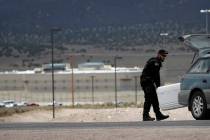It’s called the “suicide belt” — a swath of Western states that extends from the Southwest to the Pacific Northwest, then leaps over western Canada to Alaska. If you look only at the lower portion, Nevada sits about where the buckle would be.
Researchers have been aware for decades that residents of certain Western states are at greater risk of dying by their own hand — up to twice the national average in 2017.
“These rates have been elevated, and they’ve been there for a long time,” said Sam Harper, an associate professor in epidemiology at McGill University in Montreal, who coined the term suicide belt in a 2008 presentation. His research suggests the phenomenon might date to at least the 1890s, the oldest suicide-related data he could track down.
For many years Nevada had the dark distinction of having the highest rate of all before it began to fall in the rankings in 2000. In 2017, the most recent year for which national suicide data is available, it was tied for 10th with Colorado.
But that’s not because the Silver State is getting an upper hand on the problem; the rest of the nation has been catching up.
The nationwide suicide rate has been steadily rising, climbing from 10.7 per 100,000 people in 1999 to 14 per 100,000 in 2017, federal data show.
The number of those who kill themselves each year in Nevada has climbed as the population has grown. But the suicide rate has remained almost flat, dipping 1 percent since 1999 to stand at 20.3 deaths per 100,000 residents — still well above the national average.
However, statistics released earlier this year by the state Office of Suicide Prevention show a troubling spike in child and teen suicide. And the number of suicides in Clark County has outpaced population growth, rising 19 percent from 2014 to 2018 vs. a population gain of 8.7 percent over that period, according to figures from the county and the coroner’s office.
Researchers on suicide have pinpointed factors that can contribute to a person’s decision to die: easy access to guns, financial struggles, isolation, broken relationships, addiction to drugs or alcohol, bullying of children and feelings of being a burden to your family are most often mentioned.
Experts also know suicide is a phenomenon that doesn’t discriminate, though rates do vary somewhat by demographics like gender, race and ethnicity. Geography also appears to play a role, as suicide rates in rural areas — particularly those in the West — tend to be higher than in the urban centers.
Nevada checks many of those boxes. Residents, the experts note, have easy access to guns, the most common means of suicide deaths. There is also a dearth of mental health care in the state, and residents often live social isolation, either because of high transiency rates in urban areas or low population density in rural areas. In a state where games of chance are almost everywhere, problem gambling also has been cited as a possible factor.
State officials also target veterans with specialized suicide prevention efforts in a state where about 7 percent of its inhabitants formerly served in the military, according to census data.
But knowing all that doesn’t stop people from feeling lost and taking their lives — sometimes after only moments of contemplation.
‘No idea why’
Harper, the researcher who stirred discussion with his study of the suicide belt, said he hasn’t looked at the data since he did the original research. At the time, he examined various factors that can be drivers of suicide — things like higher rates of divorce, alcoholism and unemployment.
Still, even when he found those rates were elevated, none was significant enough to account for the sharply higher suicide rates.
The state’s Office of Suicide Prevention coordinator Misty Vaughan Allen has been acutely aware of Nevada’s place in the belt since she started working in the field in the late 1990s. The office provides specialized training across the state and analyzes suicide data to glean insight into the problem.
“(Nevada has) had one of the highest rates in the nation since we started our work 20 years ago, but what I also have seen is we have held steady since 1999,” she said. “I have no idea why that is.”
She can speculate. Nevadans are resilient, she said. Rugged, even. Among younger residents, the stigma surrounding mental illness is dissipating.
Vaughan Allen said she also struggles to explain why the state’s rate stabilized even though Nevada’s public health funding is the lowest in the country.
“It does perplex me,” Vaughan Allen said.
Harper said he essentially gave up trying to figure out the reasons behind the “suicide belt” and moved on to other projects.
He’s not the only researcher to throw his hands up in the air. There have effectively been no studies in the last decade to follow up on this disturbing western trend, Harper said.
Wild Country to American Dream
Matt Wray, a former UNLV professor now at Temple University in Philadelphia, and a team of researchers, including Vaughan Allen, analyzed Nevada suicide data in 2008 and found that living in or visiting Las Vegas correlated with a higher suicide risk compared with other urban areas.
In other words, something about Sin City and its promises of sex, riches and fun either attracted people who were at higher risk of suicide or elevated a person’s risk.
“The ecological explanation is that there is something about Las Vegas that is suicidogenic,” said the report, which was published in the journal Social Science & Medicine. In addition, it said, there could be “some unspecified feature of the urban environment that promotes suicide.”
The researchers could not find any evidence to support a causal effect, however, and recent data show that, as in much of the country, rural Nevada’s suicide rates surpass those of Clark County.
Dr. J. Michael Bostwick, a psychiatrist at the Mayo Clinic in Rochester, Minnesota, who studies suicidality, said Nevada mirrors other western states with higher-than-average rates of gun ownership and many residents who live in isolation — a dangerous combination.
“To my reading, it really is two states,” he said. “It’s Las Vegas and the rest of the place. And I think the profiles would be very different for those two.”
In the 2008 report, Wray presciently noted that the rapid growth and changing social mores of Las Vegas were making the city “an increasingly normal, middle-American urban destination,” while factors like increasing social isolation and the spread of legalized gambling across the U.S. were also diminishing the distinctions from the other side.
“Perhaps it is not Las Vegas which is becoming more like the rest of America,” they wrote. “Perhaps the rest of America is becoming more like Las Vegas.”
In 1999, Nevada led the country in suicides per capita, with a rate of 21.3 deaths per 100,000.
Something changed with the turn of the century. After years with the top rate in the nation, Nevada began to slide down the list. By 2008, its rate of 19.7 per 100,000 was fifth in the nation.
The state’s rate has remained fairly flat in recent years, while those of other states have surged. As of 2017, Nevada’s rate of 20.3 per 100,000 tied it for 10th highest.
Coming in June: Rural Nevada confronts problem with few resources.












